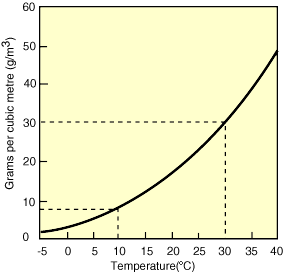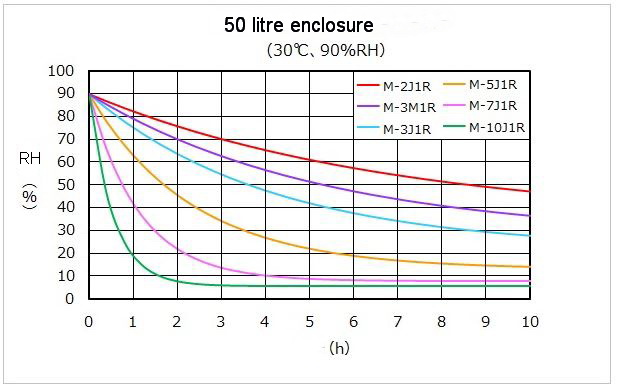
Temperature change is key to cabinet humidity control
Large temperature changes have a significant impact on relative humidity levels, and this is particularly significant when considering enclosure dehumidification. It is difficult to keep a fixed relative humidity (RH) in an enclosure you do not control the temperature change.
This article considers the important relationship between temperature change and dehumidifying enclosures using micro dehumidifier membranes, but it is also relevant in the wider context.
Rosahl membrane dehumidifiers offer a slow acting, low-energy method of drying steady-state enclosures from 1 litre to 4m^3. In this application steady state means infrequent air changes and stable temperatures.
Condensation risk and dew point
The maximum amount of moisture/water vapour carried by air is directly dependent on the temperature of the air: the higher the temperature, the more moisture it holds. As an example, one cubic metre of air at 30°C will hold 31.8g of water [called the saturated water vapour density]. If the temperature reduces to 10°C, then it will hold only 9.3g. In this example, without venting or dehumidification, the 22.5g of moisture would condense into 22.5ml of water. The temperature at which the moisture condenses into water is called the dew point.



Dehumidifier membrane selection
For most internal applications, temperature change is not usually more than a few degrees in a 24-hour period and tends not to cause problems. However, external installations can be subject to faster and wider temperature change, and this is particularly important as it affects the selection of the dehumidifier membrane. It is also good practice to operate a membrane dehumidifier 24/7 in this situation, otherwise there is a risk of condensation forming before the membrane can remove the moisture.
Worked example
Consider the earlier example of the 1m³ in a cabinet and temperature change. For a normal indoor application to maintain a cabinet internal relative humidity (RH) of 40%, and assuming a 70% ambient humidity, the selection tables identify a Size 7 micro dehumidifier membrane (MDL-7 or M-7J1R models) with a dehumidifying capacity of 16g of water per day as suitable.
At 30°C and 70% RH, the air in the cabinet actually holds 70% of 31.8g = 22.3g. Reducing this to 40% RH (12.7g) at a constant temperature requires the removal of 22.3-12.7=9.6g of water taking about 14 hours
However, if at the same time the temperatures fell to 10°, the air could hold 70% of 9.3g = 6.5g and to maintain a 40% RH (3.7g) it would need to be reduced from 22.3 to 3.7g requiring the removal of 18.6g of water taking over 28 hours
Recommendation
It is recommended therefore that for cabinets where a fall in temperature is expected, that the humidity is minimised first to avoid condensation. With membrane dehumidifiers, it still cost effective to operate them 24/7 under these conditions.
For information on saturated water vapour density, dew point and relative humidity go to the about humidity section of the website.

